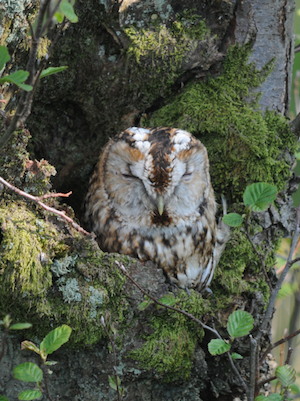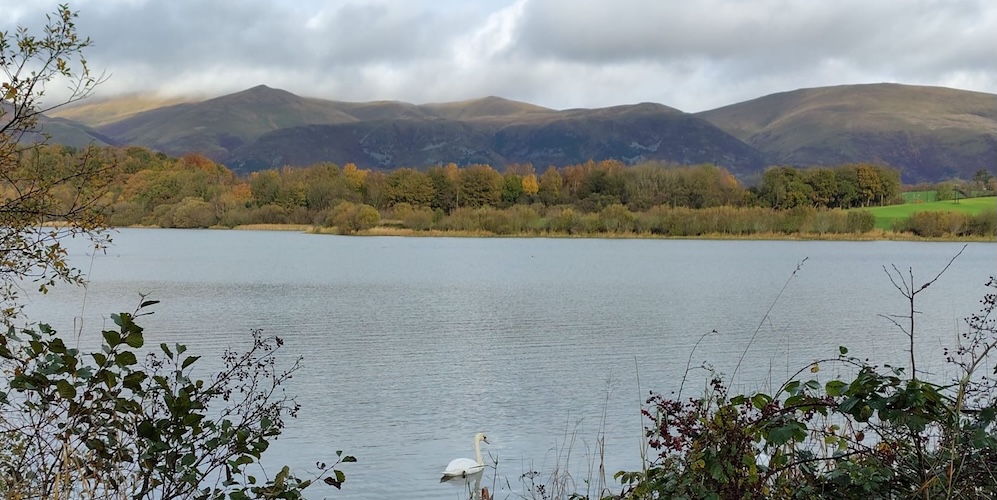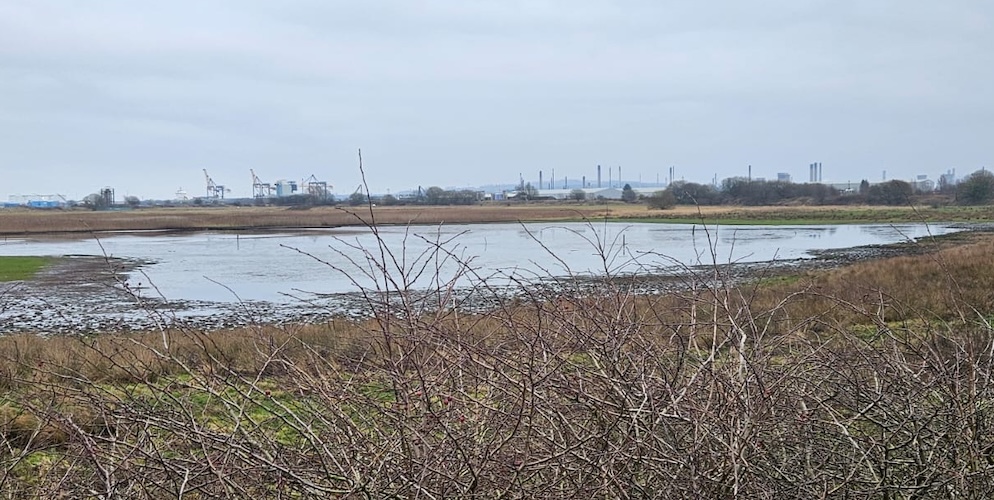Upper Forth

The SOC recording area of Upper Forth encompasses the unitary authorities of Clackmannanshire, Falkirk and Stirling (excluding Clyde basin, Loch Lomondside and other parts of the Clyde drainage basin, not including the Endrick Water, i.e. Fintry and Balfron. Carron Valley Reservoir is included. It is bordered by Perth & Kinross to the north and east, Fife to the east, Lothian to the southeast, Clyde to the south and west and Argyll to the northwest.
Birding Upper Forth

View from Gartmorn Dam – ©Graeme Garner
Stirling – The majority of the population of the Stirling area is located in its southeast corner, in the city of Stirling and in the surrounding lowland communities: Bridge of Allan and Dunblane to the north, Bannockburn to the immediate south, and the three former coal mining communities of Cowie, Fallin, and Plean. The remaining 30 percent of the region’s population is sparsely distributed across the rural, mainly highland, expanse in the north of the region. The southern half of this rural area comprises the flat western floodplain of the River Forth, bounded on the south by the Touch Hills and the Campsie Fells. North of the glen lie the Trossachs mountains, and the northern half of the region is generally mountainous in character.

Blackness – ©Graeme Garner
Clackmannanshire – Clackmannanshire is often nicknamed the ‘wee county’. The Ochil Hills lie in the northern part of the area. Strathdevon is immediately to the south of the steep escarpment formed by the Ochil Fault, along which the Hillfoots Villages are located. Strathdevon mostly comprises a lowland plain a few hundred metres either side of the River Devon, which joins the Forth near Cambus.

Black Devon Wetlands – ©Craig Mackay
There is also the Black Devon river that flows past the town of Clackmannan to join the Forth near Alloa. This confluence once had a small pier, for portage to Dunmore pier on the south shore, and anchorage of smaller sailing ships, while others of greater tonnage could be accepted at Dunmore pier on the opposite banks of the Forth.

Skinflats RSPB Reserve – ©Neil Middleton

Falkirk – The council area borders with North Lanarkshire, Stirling and West Lothian, and, across the Firth of Forth to the northeast, Clackmannanshire and Fife. The small county has a number of reserves.
-
Black Devon Wetlands
WebpageSatellite ViewBlack Devon Wetlands, Alloa: freshwater ponds adjacent to upper Forth Estuary; good for waders and gulls. Black Devon Wetlands is a quiet gem of a reserve, an area of untouched wet grassland and wetland habitat which includes freshwater pools, brackish pools and reedbeds. This new site is being developed by RSPB Scotland to be better for the people and wildlife of the Inner Forth. -
Blackness
Satellite ViewBlackness: estuary viewpoint; good for waders, gulls, duck and occasional seabirds. -
Blair Drummond Gravel Pits
Satellite View2 disused gravel pits and sounding farmland; good for duck species. -
Gartmorn Dam Country Park and Nature Reserve
WebpageSatellite ViewGartmorn Dam is a reservoir, it and the and surrounding woodland are good for ducks and common woodland species -
Head of Loch Tay, Killin
Satellite ViewThis site is good for passage waterfowl and waders - Loch Tay is a long, narrow loch of around 14.55 miles (23.42 km) long, and typically around 1 to 1½ miles wide, following the line of the strath from the south west to north east. It is the sixth-largest loch in Scotland by area and over 150 metres (490 ft) deep at its deepest. -
Kinneil Lagoon
InformationSatellite ViewKinneil Lagoon: a tidal lagoon between the Forth estuary and the Carron river; good for waders, duck, gulls. Kinneil Lagoons is located between Grangemouth and Bo’ness and is the most important waterbird high tide roost within the Inner Forth, attracting thousands of wintering birds such as knot, dunlin and black-tailed godwit each year. -
Skinflats Lagoons
InformationSatellite View2 lagoons and saltmarsh habitat east of the Skinflats village; good for waders, duck, gulls, geese, and migrant passerines. The saline lagoons and saltmarsh at RSPB Skinflats Reserve are important and increasingly rare habitats in the Forth estuary.
-
Chris Pendlebury
23 Ochlochy Park, Dunblane FK15 0DU
07798 711134
-
The Birds of Clackmannanshire
| By Neil Bielby, Keith Broomfield & John Grainser | Scottish Ornithologists Club | 2013 | Hardback | ISBN: 9780992692704 Buy this book from NHBS.com -
Where to Watch Birds in Scotland
| By Mike Madders & Julia Welstead | Christopher Helm | 2002 | Paperback | 297 pages, b/w illustrations, maps | Out of Print | ISBN: 9780713656930 Buy this book from NHBS.com

Where to Watch Birds in Scotland
Apple iOS | AndroidThis app will help beginners and experts alike to discover hundreds of the best places to see and enjoy birds around the country. Where to Watch Birds in Scotland, the cottish Ornithologists' Club's free mobile app for Apple and Android devices, now has over 580 sites. New sites will continue to be added and existing ones updated as far as possible. The app launched in April 2019 and since then has been downloaded by more than 15,000 users and amassed over 750,000 site views. It won 'Product of the Year' in Birdwatch and BirdGuides' 2019 Birders' Choice Awards, and the BTO/Marsh Award for Local Ornithology 2020.Organisations-
Green Action Trust
WebsiteWe work with a range of public, non-profit and private partners across Scotland to turn environmental policy into tangible change, building more sustainable communities and a greener country. -
RSPB Forth Valley Local Group
WebpageThe Forth Valley Local Group of the RSPB covers a wide area including Dunblane, Falkirk, Linlithgow and Stirling in Central Scotland… -
SOC Central Scotland Branch
WebpageMeetings talk place in Bridge of Allan, on the doorstep of the University of Stirling and students are always very welcome to attend! The Allan Centre, Fountain Road, Bridge of Allan, FK9 4AT
Reserves-
Argaty Red Kites
WebsiteSatellite ViewWelcome to a farm Where red kites soar through the clouds And red squirrels leap through the trees -
CP Muiravonside
WebpageSatellite ViewMuiravonside is Falkirk's only Country Park, providing 170 acres of stunning woodland and parkland, a mini demonstration farm, a sculpture trail, children's play area and a café at the Visitor Hub courtyard. The park is free to access all year round and offers spectacular scenery accessible through a network of paths. -
FLS Forest & Land Scotland
WebsiteSatellite ViewThe Central Scotland Forest Trust (CSFT) leads the partnership which is creating the Forest. It is supported by formal partners (the Scottish Executive, Scottish Enterprise and the LECs, the Forestry Commission, the area's five Local Authorities and Scottish Natural Heritage) and informal partners including local communities, voluntary organisations, the private sector and the area's farmers and landowners… -
FLS Queen Elizabeth Forest Park
WebpageSatellite ViewEnjoy iconic views of sparkling lochs, wooded hills and rugged mountains, or take to the trails on foot, by bike or on horseback and discover the Forest Park’s magical atmosphere and wonderful wildlife. -
LNR & CP Gartmorn Dam
WebpageSatellite ViewClackmannanshire has a rich mining history and many signs of this heritage are still visible. None are so impressive as Gartmorn Dam, lying at the heart of the local 370 acre Country Park and Nature Reserve. -
LNR Bonnyfield
WebpageSatellite ViewBonnyfield Nature Reserve is situated on the former Bonnyfield sand and gravel quarry just to the north of the Bonny Water and to the west of Duncan Stewart Park. It is a large area offering natural habitat to a wide range of plants and animals. One of the most important and unusual habitants is the Burnet Moth. -
LNR Kinneil
WebpageSatellite ViewA former colliery site in Bo'ness became Falkirk Council’s second Local Nature Reserve in March 2013. Official local nature reserve status was conferred on part of the Bo’ness and Kinneil Foreshore, once home to Kinneil Colliery. The new reserve stretches from Bo’ness harbour in the east to the site of the former Kinneil Colliery and Snab Lane in the west. The mudflats and "island" off the foreshore are internationally important for seabirds and are already designated as a Special Protection Area for their conservation value. -
NP Loch Lomond & the Trossachs
WebsiteSatellite ViewWith its woodlands, mountains, tranquil lochs and glens and rocky coastline of our sea lochs, Loch Lomond and The Trossachs National Park is brimming with wildlife. There are four distinctive areas of the National Park – Loch Lomond, Cowal, The Trossachs and Breadalbane. -
RSPB - Black Devon Wetlands
WebpageSatellite ViewBlack Devon Wetlands is a mosaic of untouched wet grassland and wetland habitat including freshwater pools, brackish pools and reedbeds. Located on the Inner Forth, the reserve is set back from the river and forms an important area for large flocks of wintering wading birds and wildfowl. There are currently no facilities on the reserve, but over the next year we will be creating a fantastic place for everyone to come and learn about and enjoy this hidden gem on the Inner Forth. -
RSPB Skinflats Reserve
InformationSatellite ViewThis reserve is primarily intertidal mud and a small area of saltmarsh. A small field is planned for managed retreat in the next five years. Key birds include migrant and wintering wildfowl, pink footed geese and waders. -
SWT Ballagan Glen
WebpageSatellite ViewBallagan Glen is a small but beautiful reserve carved by the Ballagan Burn, which cascades down a series of waterfalls, including the Spout of Ballagan. It is notable for its spectacular geological exposures and ancient ash gorge woodland. -
SWT Bo’mains Meadow
WebpageSatellite ViewThis reserve has two meadows: the northern meadow, which was a former reservoir that has been filled in, and the southern meadow, which has been undisturbed for many years and is now a wonderful unimproved species-rich meadow. -
SWT Cambus Pools
WebpageSatellite ViewCambus Pools is a wetland reserve with reedbeds, grassland and open water attracting waders, warblers and wildfowl. The reserve is located behind an industrial area on the Inner Forth estuary and demonstrates how small areas of land can become vital habitats for wildlife, such as reed buntings. -
SWT Carron Dams
WebpageSatellite ViewCarron Dams is a partially drained reservoir with wetland, rich fen and deciduous woodland. Specialised plants such as gypsywort, remote sedge and water-plantain thrive in the wetlands, which is one of the largest in the area. Water voles and water rails may also be glimpsed along the banks. -
SWT Carron Glen
WebpageSatellite ViewCarron Glen is a beautiful native oak and ash woodland along a steep-sided gorge carved by the River Carron. The canopy is animated with woodland birds and the river provides prime fishing for dippers and kingfishers. -
SWT Jupiter Urban Wildlife Centre
WebpageSatellite ViewIn the middle of industrial Grangemouth, Jupiter is a fantastic example of how wasteland can be transformed into an urban green space that provides a rich habitat and haven for wildlife. The centre is open all year and there are lots of ideas for improving gardens for wildlife. -
SWT Wallacebank Wood
WebpageSatellite ViewWallacebank Wood is an ancient semi-natural wood with oak, Scots pine, beech and larch, and an understorey of alder, holly, hazel and rowan. The ground is carpeted with grasses and woodland plants, including wood anemone, dog’s mercury and beautiful bluebell displays.
Sightings, News & Forums-
UpperForth Bird News
Sightings & NewsLocal bird recorder for the Upper Forth region. Used for local bird news. See @UForthBirder for personal birding tweets.
Places to Stay-
Campbell Cottage
WebsiteIf you are looking for a dream ‘get-away-from-it-all’ holiday, you must come and visit our holiday cottage near Stirling, Scotland. Campbell Cottage is situated in the beautiful village of Dollar in the Hillfoots in Clackmannanshire. It is a perfect location for visiting Stirling, St Andrews, the Trossachs and the picturesque countryside nearby. There are excellent transport links via road and rail to Edinburgh and the rest of Scotland.
-
Fatbirder - linking birders worldwide...
Skip to content
